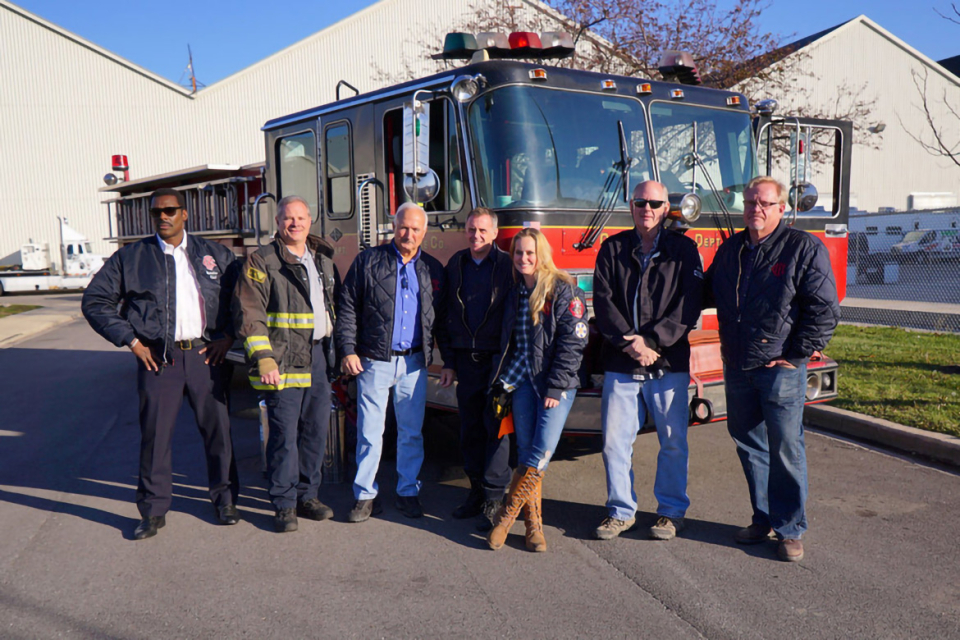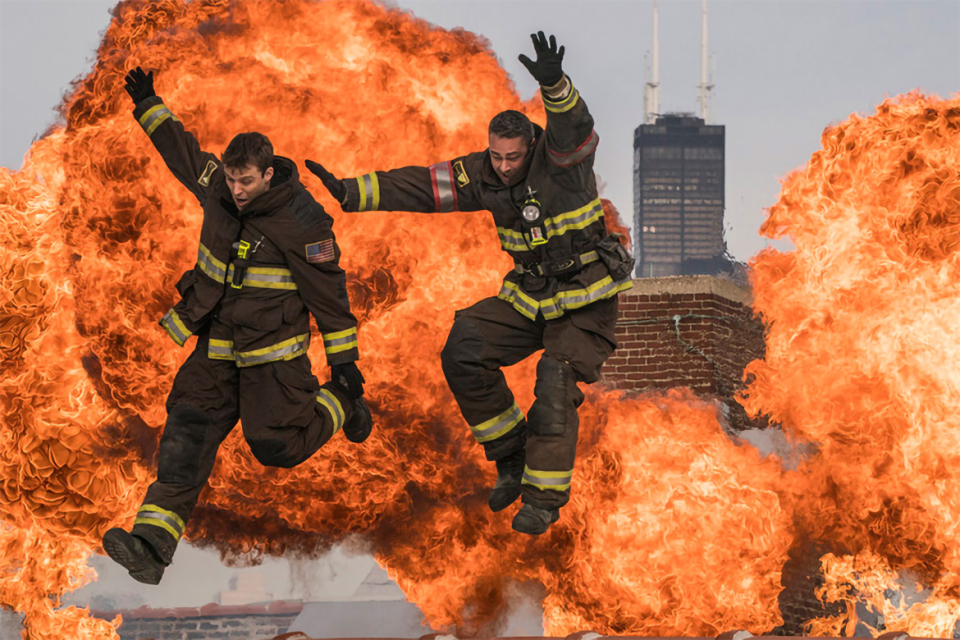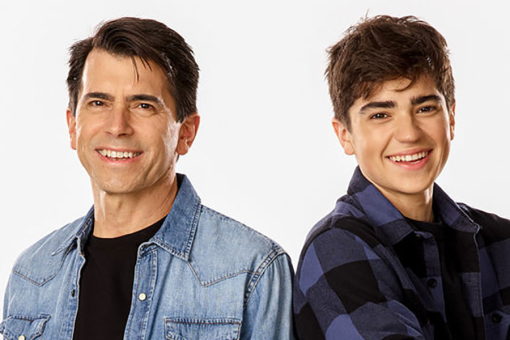Through six seasons of Chicago Fire, special-effects coordinator John Milinac has burnt down countless numbers of structures, complete with raging flames, explosions and billowing black smoke.
And then there are the heart-pounding car crashes and other accidents requiring swift emergency response.
But with every single perilous incident on the NBC drama, one thing remains paramount - the safety of his cast and crew.
Since the pilot episode premiered in October 2012, the Chicago-area native has overseen a talented team of technicians charged not only with making the fires but with bringing the chaotic rescue sequences to life for the firefighters and paramedics based at Firehouse 51 of the Chicago Fire Department.
Chicago Fire was created by Derek Haas and Michael Brandt, who act as executive producers with Dick Wolf.
Whether it's a raging inferno, a medical emergency or even a cat caught in a tree, Milinac creates, supervises and executes all of the on set and on location scenes for the drama, which stars Jesse Spencer, Monica Raymund and Taylor Kinney.
Milinac began his production career by talking to crew members working on the Windy City set of 1980's The Blues Brothers and getting their input on how to enter the business. After honing his skills at a special effects company in Los Angeles and on a number of films, a little more than a decade later, he was working on Backdraft with director Ron Howard.
Among his more than 50 credits are Courage Under Fire, Con Air, 8 Mile, Man of Steel, The Negotiator, Lorenzo's Oil, Road to Perdition and The Last Samurai.
Milinac says his work in television is a constant challenge to make the special effects look as movie-like as possible, performing what's required within a fraction of the time he has on a feature.
We caught up with him by phone from the set in Chicago as he was prepping for the next episode.
What stands out as far as how things have grown over the course of six seasons of Chicago Fire?
From the pilot, we always knew it was going to be a cinematic look, large scale from the beginning. Our genetics call for a big look. Certain episodes cater more to that, with larger-scale fires or incidents. There's an ebb and flow to that, and to make sure we can accomplish it. Our adaptability is key to a big episode and how to achieve it.
The boundaries are limited to the amount of days. Some stuff is new, others things we may not have gone back to for a while, but we look at what we can do within the timeline to take it to another level. Things are more challenging now, to do what we do in the amount of time we have and keep a cinematic look.
What is your process of working with the production team?
The arc is an eight-day prep for an eight -day shoot. When we start prepping the next episode, there's a lot of R & D. If we do back-to-back to fires, and strike those, we have to reverse engineer those and impart no harm to the location. Typically there is more than one event.
There's a second layer in every episode, like a car crash, but we have to ask if it makes sense, that it looks good and is repeatable safely. It's still TV time to do what might be a feature idea.
Like many shows, we start every episode with an outline, take it to a concept meeting and look at something that shifted or some other modifier. From concept, our department works with the production designer, (Craig Jackson) the director and the art director and looks at access to locations, as their availability doesn't always allow shooting.
Once we're moving that way, we move into a production meeting and dot the I's and cross the t's. In filming, it's still evolving. Special effects is kind of a hub department. We help art, stunt and the director of photography. We break out in different directions to help on different levels – some cater to the art department and sometimes it's more heavily with stunt and we work with their riggers.
Associate producer Steve Chikerotis is our advisor and fire liaison. He was a CFD district deputy fire chief, and a lot of the stories come from his experiences. Rick LeFevour is our stunt coordinator. We work closely with set decorating and the construction department. Everyone is participating--it's a collective between all departments. There are certainly a lot of people behind the scenes to make it all work.
Can you talk about the difference between "practical special effects" and visual effects (VFX) — and how that separates Chicago Fire from other shows on the air.
We do a low percentage of VFX. We do almost everything on camera - fires, car crashes - very few are sent to the VFX team. With a burning building, if the wind is not in our favor, they may create smoke. If the fire is not reactive enough, not full value, they may put on another level to supplement the look.
Tell us about the fire/burn stage at Cinespace where shows are based. I understand it used to be a steel plant.
Cinespace is made up of very large spaces, and one is designated for all fire, with multiple set scenarios that can be reconfigured based on script or matched to location. If there is a two-story building with fire coming out the windows, the interior space has to feel like it is right, perhaps with more hallways or more bedrooms. It's all managed on the burn stage.
All materials are known to us as being fire-safe or resistant. Those sets can tolerate repeated burns without breaking down. We're always wearing safety gear, and the stage is ventilated every few takes. It's adaptable like a soundstage with different laboratories, with everything made to tolerate the heat and smoke.
What are the safety precautions that you take for every fire and accident scene?
It varies. If the fire is at location, we have to prep the concept. Here's the building, here's the windows, here's the smoke. We then scout it, change out the windows and put fireboxes in them so that we can control from the inside all the fire sources. Also the hoses and operators so we can bring them up sequentially for every shot.
The fire department is working hand in hand with us and if something is not as planned, they're prepared. We make sure we don't do long takes. There are fire extinguishers everywhere. The crew understands what's going to burn, and what's smoking. Everyone is on their toes and if they see something, they say something. The whole crew is acting as safety-minded people.
Have you had any close calls?
We consider this an industrial job, and any incidents have been minor, but sometimes a trip over a cable can be unsafe. We spend a lot of time and diligence to make sure everyone is safe.
What is your interplay with actors?
The actors know they can talk to us with any concerns, and we always communicate what they can expect to be happening. Our relationship is strong and they've grow to trust us. As far as the writers; they keep challenging us to do bigger things.
With half of the show shot on location, how does the Chicago weather affect what you do?
Like with any show shot here, the Chicago weather is an adversary. Although the shooting crew is local and very well-adapted - and many of the general crew has been here the entire run – it doesn't make it any less challenging. We don't change storylines because of the weather. The location still has to be prepped, and we often work on rooftops. If there's a heavy snowstorm, predicted or not, we have to be prepared.
How do you work with the other Wolf Films Chicago shows?
Our department rarely crosses over to Chicago P.D. and Chicago Med but I know their department heads well, and we consult when we work on each other's sets.
How did you first get into the business?
I grew up northwest of Chicago, in McHenry, where I live now. I shot 8mm film in the backyard. At the time, in the mid-1980s, the Chicago production scene was challenging.
I had to move to Los Angeles where I worked for a company called Special Effects Unlimited, which did mechanical effects, before moving back to Illinois and filming Backdraft, as an effects tech. Ironically, John Roman, who worked on the film, started taking me to other productions overseas and now we work together again on Chicago Fire.
I understand you are an artist as well and do sketches.
When I have some time I like to draw. The art department picked some of my pieces, like [the bar] Molly's, completely recreated from the real location. It's one of our anchoring sets, and most of the time, the end of our day. One piece was requested for the Molly's set, a Korean War aircraft, an F-86 Sabre jet fighter with the name Molly on it. That's the owner of the bar's wife's name on the plane.
How has your craft evolved over the decades?
It is an evolution. The hardest thing 10 years ago is not hard now. The biggest thing is how the technology has changed. Information travels faster and you must react faster. TV is always much faster than the timeline or arc of a feature film, and with a drama like ours with a lot of events, we have to make sure everything is firing on all cylinders from department to department.
Everything is evolving from our perspective. There is peril on top of peril and we need to make it sustainable from story to story. The writers set the table for what we have to do and it is always something bigger and better. The show will continue to have characters the audience cares about and that's the important thing first. The incident is in the background and the story stays with the characters and their bond with the audience.
But if there's ever a dull moment, it won't last long… The next script will challenge us in a different way, and the next thing to do.














